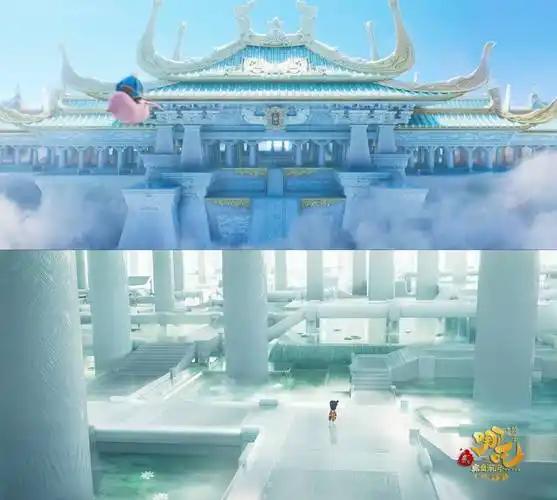AInvest Newsletter
Daily stocks & crypto headlines, free to your inbox
Yuxu Palace Design
The design of Yuxu Palace has a similar shape to the Pentagon, but it has eight cornersis, inspired by the classic Taoist Bagua (Eight Trigrams). The Bagua is a set of symbols from Chinese philosophy that represent the nature of reality, composed of opposing forces that reinforce one another. Each trigram is made up of three lines, either broken or unbroken, representing yin and yang. These symbols symbolize duality, with each line having two possible states, leading to a total of 8 trigrams.


At the center of the palace design is the Taiji symbol. In Chinese philosophy, Taiji represents the cosmological state of the universe, reflecting the dualistic balance of yin and yang, and the interplay of the Three Treasures and the four cardinal directions.
Yuxu Palace and Jade
Upon entering Yuxu Palace, Ne Zha is struck by the entire palace being built from pure jade, exclaiming multiple times, So white, really white. In Chinese culture, jade holds a significant status, revered as the crystallization of the energy of heaven and earth. Historically, Chinese emperors collected jade artifacts to symbolize their imperial power. The most famous piece of jade in Chinese history is the Heshibi, which was carved into the Heirloom Seal of the Realm during the Qin Dynasty, symbolizing the Mandate of Heaven. The palace built entirely from jade suggests that it is of the highest level, fit only for the most elite deities.
White also holds symbolic meanings in Chinese culture, representing purity and holiness. The jade palace appears sacred and majestic, providing a stark contrast to the antagonist's actions.

Immortal Jade Pendant
The pendant worn by the Taoist immortal in the film shares similarities with the U.S. national emblem, but it is not related to the U.S. The pendant features a large bird in the center, which is believed to represent the Vermilion Bird, one of the Four Mythical Creatures in Chinese mythology, symbolizing fire. The circular symbol above may represent the sun, linking the theme of fire to Ne Zha's elemental attribute of fire.

Tian Yuan Ding (Heavenly Cauldron)
In Chinese culture, the ding (cauldron) is a symbol of power and divine mandate. One legendary artifact is the Nine Tripod Cauldrons, which represented the authority granted to the ruler by the Mandate of Heaven. The cauldrons were cast by Yu the Great of the Xia Dynasty. In Ne Zha 2, the breaking of the Tian Yuan Ding symbolizes a rebellion against the existing hierarchies and systems, aligning with the central theme of the film.

It is worth noting that the top of the Tianyuan Ding has a pattern that resembles the dollar sign, but it is not the same as the real dollar sign. The pattern of Tianyuan Ding is an S with two vertical bars, while the dollar sign is an S with one vertical bar. In fact, the characters carved on the bronze tripod in the Shang Dynasty are basically oracle bones, and the patterns of the Tianyuan tripod are more likely to be a fusion of the characters tian and yuan in oracle bones.

The film frequently references the elixir of immortality, a concept in Taoism where elixirs are used to achieve immortality or longevity by transforming one's internal energies. Chinese emperors were obsessed with alchemy, believing that consuming such elixirs would grant eternal life. The Tian Yuan Ding in the film plays a role in creating these elixirs.

Reference to Journey to the West Memes
In the film, after Ne Zha enters Yuxu Palace, he urinates at the dew collection area, and the dew is collected and turned into high-quality immortal dew, which is then mistakenly consumed. This scene is a tribute to the episode in Journey to the West where Sun Wukong deceives demons by using urine disguised as holy water.

At the film's conclusion, the Tian Yuan Ding transforms stones from the Dragon Palace into a shining rod, resembling the Ruyi Jingu Bang, a legendary weapon in Journey to the West used by the Monkey King (Sun Wukong). This may hint at the future appearance of Sun Wukong in upcoming films.

In Journey to the West, Sun Wukong does indeed battle Ne Zha and defeats him. However, Wukong's story takes place several hundred years after Ne Zha's timeline. The director of this film has expressed hopes of creating a Chinese mythological universe, suggesting the possibility of a Chinese version of the Marvel Cinematic Universe.
Fantastic stocks and where to find them

Oct.14 2025

Oct.13 2025

Oct.10 2025

Oct.09 2025

Oct.08 2025
Daily stocks & crypto headlines, free to your inbox
Comments
No comments yet